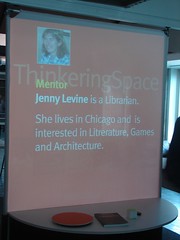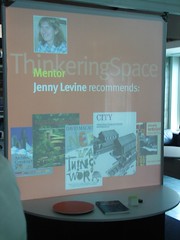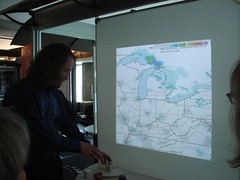new posts in all blogs
Viewing: Blog Posts Tagged with: jon udell, Most Recent at Top [Help]
Results 1 - 7 of 7
How to use this Page
You are viewing the most recent posts tagged with the words: jon udell in the JacketFlap blog reader. What is a tag? Think of a tag as a keyword or category label. Tags can both help you find posts on JacketFlap.com as well as provide an easy way for you to "remember" and classify posts for later recall. Try adding a tag yourself by clicking "Add a tag" below a post's header. Scroll down through the list of Recent Posts in the left column and click on a post title that sounds interesting. You can view all posts from a specific blog by clicking the Blog name in the right column, or you can click a 'More Posts from this Blog' link in any individual post.

By: Jenny Levine,
on 6/18/2008
Blog:
The Shifted Librarian
(
Login to Add to MyJacketFlap)
JacketFlap tags:
collaboration,
jon udell,
illinois institute of technology,
institute of design,
macarthur foundation,
thinkering spaces,
iit,
remixed library,
libraries,
Add a tag
Yesterday I gave an overview of the Thinkering Spaces project, so today I want to explain a little more about how we were able to manipulate content using the various technologies and objects.
 RFID is a big component of the system, as it identifies content and allows it to travel with an object. To start, the TS folks put a book with an RFID chip on the reader, which triggers a process that displays the cover on the screen, along with a keyboard for typing text to associate with the title. In this case, the container is the book, and the user can draw or type to add content that will travel with it. To illustrate this, they remove the first book and put a second one on the reader. A new cover image appears, along with some information that’s already been added by a previous user. Take that book off and put the first one back on, and the content we added reappears. The whole thing is very cool, and I immediately started thinking about local history collections, schoolwork, and reader reviews. All of which is the point - your librarian mind starts hopping with possibilities.
RFID is a big component of the system, as it identifies content and allows it to travel with an object. To start, the TS folks put a book with an RFID chip on the reader, which triggers a process that displays the cover on the screen, along with a keyboard for typing text to associate with the title. In this case, the container is the book, and the user can draw or type to add content that will travel with it. To illustrate this, they remove the first book and put a second one on the reader. A new cover image appears, along with some information that’s already been added by a previous user. Take that book off and put the first one back on, and the content we added reappears. The whole thing is very cool, and I immediately started thinking about local history collections, schoolwork, and reader reviews. All of which is the point - your librarian mind starts hopping with possibilities.
Then they showed us a library card with an RFID chip in it. This one happened to have information about me stored on it, so putting it on the reader brought up information about me, which rotated with books I recommend. Others in the Thinkering Space could see all of this about me, which would be great if I was working with a group I’m mentoring, coordinating, or collaborating with. The IIT folks understand the privacy issues involved, though, so they’re exploring different ways to handle this. Alternatives include using avatars without personally identifiable information, having the group build a persona to achieve certain skills, and using special cards for collaborative clubs rather than embedding the information in standard library cards (this would provide an opt-in system). None of this is set in stone, but it demonstrates one way in which library users might share information about themselves in the physical library.


Next, we began playing with the story of The Wizard of Oz by placing a Rubik’s Cube with RFID chips on it on a reader. The starter Oz content is attached to this container and it can include the text and images from the book itself. Placing a second, blank, paper “storycube” on the reader brings up a template where someone can use a wand to drag and drop images into a template to tell a story, which can then be saved to another object (in this case, it was a small doll). Putting a second doll on the reader brought up someone else’s story. The container could be anything that uses RFID or barcodes. Turning the cube produces other content, such as weather maps (watch for tornadoes), and putting a camera on the reader brings up pictures and images related to the book, all of which can be manipulated on the screen.



TJ then took some pictures of the group and other objects in the space, and since his digital camera had an Eye-Fi card in it, the pictures began appearing on the screen as well. We could then mash up these pictures with text, sounds, and other digital content to create a narrative, a presentation, a document, or just explore them all together. The space also has a digital microscope and a webcam that can project images onto the screen as well.
We also played with a collaborative drawing table that just does a basic coloring demo right now. However, the idea is that there might be some projects where users can work on their own pieces separately to build a larger whole, or they may have to collaborate and work together as a team to create something. Sometimes they might have their head down working, but other times they might have their head up, interacting with the other participants. Pretty much everything in the space is based on collaboration, as opposed to single users.
What I like about these ideas is that they expand on existing content in the library, using the library’s collection, and mashing it up with users’ ideas to create something new. It’s Jon Udell’s remixed physical library, not just the online one. Or the users create something new from the beginning, based on their interactions with our collections and services. The community can contribute content and knowledge, and the library could archive it.
And it doesn’t have to be just for kids or students. For seniors who have trouble using a mouse and a computer, a setup that lets them use a wand (or even better, their fingers) to drag objects might allow them to play with digital content (especially local history) in different ways. Could families create genealogical histories this way and mash them up with community resources? The Shanachies in the Netherlands intend to build a giant screen in the DOK Library Concept Center where residents can post their own stories and pictures. Imagine combining that with library cards that let those residents update their stories and remix them in a Thinkering Space.
It will be interesting to see what happens to things like narrative and copyright in these types of environments. One of the questions now is will libraries be one of them? This project gives me hope that the answer is yes, and honestly, what better institution do we have in which to discuss, explore, and implement the answers?
collaboration,
iit,
illinois institute of technology,
institute of design,
jon udell,
libraries,
macarthur foundation,
remixed library,
thinkering spaces
Jon Udell (non-librarian of LibraryLookup fame) continues to provide services for library patrons that libraries and their vendors don’t. We can debate whose role it is to provide this, but I wish my home library would adapt this and make it work for me. Speaking from the patron side of things, these kinds of lightweight solutions that do the work for me fit into the way I live and work.
LibraryLookup by Email!
This page offers an email-based version of the popular LibraryLookup service. It will alert you when a book on your Amazon wishlist becomes available in one of the Keene libraries.
If you want to try this with your own Amazon wishlist, you’ll need your own wishlist code. To find it, sign in to Amazon and follow these steps….
Lucky Keene Library patrons….
Sorry, Jon - had to out you. The needs of the many outweigh the needs of the few. 
jon udell,
librarylookup
Donald (sorry for earlier mistake) Cohen hints at it in his letter today. Anthony Pellegrino included it in the assumptions made in his column earlier this week. We hear it all of the time--islanders, that is, the Chamorros and Carolinians of the NMI, don't want to do the work that has been handled by the foreign workers, because they're lazy!
I beg to differ.
This is a stereotype like the "shiftless Negro" of last century, or the siesta-taking Mexican--both prominently featured at times in America. It's a false icon that has worked its way into the dialogue and needs to be challenged.
I've been here 23 years. I know people in most segments of the community. I work with Chamorros and Carolinians in my office on a daily basis. They're not the exception. They represent the excellent quality of workers that exist in the local community. And although I work in an office, it's not all paper work. There are times when we all pitch in to haul water, clean the office, repair our dilapidated surroundings. In the past we've moved locations. And everyone, especially our local staff, has worked hard at these jobs, too.
We've all seen islanders sweat and endure hours and hours of hard work on their local farms, or preparing for fiestas and other events. This is real work. We know Chamorros and Carolinians who have moved in droves to the mainland U.S.A. for better jobs.
There is no lazy gene in the local talent pool. When the motivations are there, islanders work as hard as anyone else.
The problem is the issue of motivation. What U.S. citizen wants to work for a mere $3.55 / hour? (And that represents a raise from the $3.05 that prevailed as minimum wage until July 2007!) If islanders value their work at a higher rate than $3.55 / hour it doesn't make them lazy; it just means that they are fortunately not as desperate as the impoverished foreign contract workers who will accept any low pay. If the local islanders are moving to the mainland for jobs (which they are), they're not expecting to laze about. They're working hard, but getting higher pay that their work deserves.
I've heard complaints from Saipan employers about their local staff taking off for funerals and family needs. I've known locals who gave up their jobs for these types of reasons. All to whom I've spoken at these times seem ignorant about the federal law, the Family Leave Act. We could do with some better education on this law and the protections it affords. We could use a local law that extends this act to all employers, including the small ones. Then there would be fewer problems with these personal issues.
Just because foreign workers have fewer rights, less status and are more vulnerable, they complain less. That doesn't mean the local worker is a bad employee.
Of course there are some who will not work no matter how high the pay or good the opportunities. These people exist in all cultures. But they are a small minority.
So let's stop assuming that Chamorro and Carolinians do not want to do the hard work, the construction jobs, the farm work, the cleaning and service jobs. And let's stop pretending that it's all about "training." There is some training needed, especially for construction, but that can be met with voc-ed classes and on-the-job training the same as in the mainland.
We don't need special rules to get locals into the workforce. We don't need special opportunities and more expensive "training."
What is lacking is "motivation." And motivation could be instantly supplied with a higher minimum wage, one comparable to that in the mainland U.S.A., exactly what has lured hundreds and possibly thousands of locals to the mainland in the past few years.
What we have instead of sufficient motivation is this foolish, slow adjustment of minimum wage that is designed for failure. It's designed to cost employers just enough to cause problems and not provide enough boost to workers to make a difference--so that it can be shut down and stopped, and the further increases can be scuttled. And it is designed so that suppressed wages at the horribly low amounts can be continued.
With higher wages in the private sector, the local population will step up and WORK! Employers will be less tempted by cheap foreign labor, which won't be as cheap any more. Those foreign workers who remain in the CNMI will be treated better, too, at least economically, with higher wages. And everybody will win. Those earnings, in whole or in part, can be spent here, or saved here, and help restore our economy.
So please, everyone--including our elected leaders here, and our community and federal leaders-- stop assuming that locals do not want to work in real jobs. Stop assuming we need labor laws that grant special privileges to our local population. Our elected leaders especially need to stop pushing for desk jobs and management positions for locals. Let's honor all work--not just with "labor day" and recognition that the leader of our Christian community was himself a carpenter. Let's honor it with a living wage and the courage to treat people who have blue collar jobs as important, contributing members of our community.
We have a diverse community, and a range of talents, skills and interests even among our local populations. Let's embrace this diversity. Let's provide the motivation for work by everyone, in whatever jobs are needed to be done. That motivation would be higher wages, decent wages, a "living wage."
And then let's see who is "lazy."

My first job was at a Chicken Restaurant called Chicken Coop, when I was fourteen years old. Everyone in my high school worked there so it was like going to school again after school everyday, and boy did we have a blast. I was fired and rehired on many occasions, and for various reason’s the worst of which I ‘m writing about today, in honor of Labor day. Let me start out by saying I was distracted by one of the managers, Mark, who was the good looking one with sandy colored hair and hazel eyes.
We had another manager who was Mark’s exact opposite: Harold. Harold was the owner’s son and for some reason he hated me, well, it could have been because I moved my mouth when a friend of my spoke under the counter one time at the register. In other words my mouth would move but my friends voice come out when asking customers for their order.
I guess that was poor form, but Harold really did seem to have it out for me from day one anyway.
He had the weirdest looking face, that I’ll never forget, his eyes were straight across from each other, perfectly aligned with one long eyebrow across the top of his forehead. He had a small, Charlie Chaplin-like mouth and he walked like Chaplin too, with a wobble. Oh, Harold hated me and especially after this incident… although more were to follow….
Each of us had a job or position in what they called the bagging or frying system for getting orders out quickly. This is how is worked: one person worked as the fryer, that fried the chicken and put it in a big pan, then the fry picker picked up the chicken ordered with thongs, put it in a cardboard dish, and slid it along a table to the bagger, the bagger put the cardboard dinner box in a bag, stapled it shut, ..and brought the finished order stapled securely in the bag to the customer waiting at the counter.
Normally, I worked as the fry picker, but this particular day the fryer (the one that fried the chicken) and I got in an argument. He was angry with me for picking the freshest chicken first, instead of the other way around. Harold had to break up the fight which was right in front of the customers, because they were right in front of us, and the fryer was a crazy man, screaming bloody murder.
Of course, Harold blamed me for the fryer actions who continued his complaining in front of the customers, but he needed me up front, so he just put me to work stapling the bags after he put the cardboard boxes inside.
This is how it worked; the fry picker picked the chicken, put it in the cardboard dinner box, and slide it to Harold, Harold would put the box in the bag, and passed it to me, who stapled the bags and brought them to the customer at the counter.
We did this behind the counter in front of the customers, so they could see their chicken being picked, put in the bags, then be on their way quickly out the door.
The service idea was set up so that the customer to get their order quickly, so the quicker we moved the better. But remember, Harold was furious with me, so he was screaming while we were trying to fill orders during the lunch hour, ...
“Ann, watch what you’re doing, I not kidding after today you are gone, gone, gone!”
Harold said, his face as red as a beet, and narrow eyes glaring at me hard.
Move it, move it, …. he yelled, his voice trailing off as I focused on stapling his tie to his shirt! He just keep on screaming until he was literally blue in the face, sliding the dinner bags toward me, where I would catch the bag from him, staple his tie to his shirt, then bring the order to the counter for the customers unstapled, and say thanks for coming and have a nice day! .
Then the customers of course started laughing, and Harold looked down at his tie! He saw about thirty staples stapled to the front of his shirt, and realized what I was doing.
I’m so glad I had my brothers car that day , because Harold went to the back of the store for some reason, and he sure wasn’t happy. That is the first time I was fired from a job.
 Years of Dust, By Ben Shahn, Resettlement Administration, 1937, Photolithograph
Years of Dust, By Ben Shahn, Resettlement Administration, 1937, Photolithograph
Franklin D. Roosevelt Library, National Archives and Records Administration
 Lest We Forget
Lest We Forget , By Ben Shahn, Resettlement Administration, 1937, Gouache and watercolor in bound volume, Franklin D. Roosevelt Library, National Archives and Records Administration
------------------------------------------
Labor Day is Monday September 3, 2007. And of course it's another great day to read. If you're looking for books to read with your kids, head to the library or your own shelves and find something that fits the occasion. Need ideas? See this list: Horn Book's Recommended Reading for Labor Day.
I'd add CLICK, CLACK, MOO--COWS THAT TYPE, by Cronin and Lewin (Simon & Schuster, 2003) to the list of picture books.
And IQBAL, by Francesco D'Adamo (Simon & Schuster, 2003) for mid-grade and YA.
 RFID is a big component of the system, as it identifies content and allows it to travel with an object. To start, the TS folks put a book with an RFID chip on the reader, which triggers a process that displays the cover on the screen, along with a keyboard for typing text to associate with the title. In this case, the container is the book, and the user can draw or type to add content that will travel with it. To illustrate this, they remove the first book and put a second one on the reader. A new cover image appears, along with some information that’s already been added by a previous user. Take that book off and put the first one back on, and the content we added reappears. The whole thing is very cool, and I immediately started thinking about local history collections, schoolwork, and reader reviews. All of which is the point - your librarian mind starts hopping with possibilities.
RFID is a big component of the system, as it identifies content and allows it to travel with an object. To start, the TS folks put a book with an RFID chip on the reader, which triggers a process that displays the cover on the screen, along with a keyboard for typing text to associate with the title. In this case, the container is the book, and the user can draw or type to add content that will travel with it. To illustrate this, they remove the first book and put a second one on the reader. A new cover image appears, along with some information that’s already been added by a previous user. Take that book off and put the first one back on, and the content we added reappears. The whole thing is very cool, and I immediately started thinking about local history collections, schoolwork, and reader reviews. All of which is the point - your librarian mind starts hopping with possibilities.
















Well said as usual and right on. Tons of locals are entering the military, which is hardly the path of the lazy.
Good point, Jeff, and one I should have added.
Thank you Saipan Writer. Very well said.
I am a local and I have been a grocery stocker and bagger boy for the former Town House, night janitor for Bank of America, customer service/ticketing agent for Continental Micronesia, govt employee in different capacities, bartender for Hamilton's, student, construction helper (worked for contractors such as Greg Cruz's dad and Tun Josen Mariko), paged for the Congress of Micronesia, special assistant to a US Senator, legislator for 2 terms, election official (my present job), special assistant to 3 governors, an Army reservists, and I enjoyed all the experiences. Of course, some of the jobs paid better than others but they were all worth it.
Pay decent wages and you will get good employees, I say.
Thanks Kilili for making my point with your specific experience!
Well said. Ethnicity does not mean lazy. That stereotype doesn't speak to work ethic, reality or political correctness, does it?
I will say this though: In my experience, heat and humidity of island living makes anyone a bit more slow moving! At least, I'm a sloth, given the opportunity.
Great post, Jane.
To copy Greg, I've dressed up as a giant dog in a parade, solid $17 hamburgers to British tourists, delivered newspapers on a bicycle, taught English, sold insurance, managed a restaurant, worked in crowd control, written for a newspaper, planted trees and sold candy at different times in my life to make a living.
Angelo, Sounds like a fun resume!
I agree with you totally. It disturbs me everytime I read nonsense about "local workers". The argument, when used by folks here, is used to justify "cheaper labor" and "unreasonable control".
I do believe, however, that such arguments will continue to be made until such time that non-resident workers are in a position to be able to fight for their basic rights as employees (i.e.-better pay, leave, time off for necessary family matters, etc.).
Thank you Saipan Writer!
The letter that you refer to in your first sentence, supposedly hinting that locals are lazy, was not from David Cohen but from DONALD Cohen. The points you make in this post are well taken, but you should make that correction for the record.
Aargh! Thanks for pointing out that mistake. It's too late to correct in the version I sent to the papers, tho!. Sheesh.